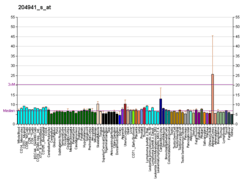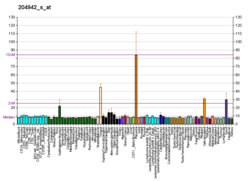Aldehyde dehydrogenase family 3 member B2 is an enzyme that in humans is encoded by the ALDH3B2 gene.[3][4][5]
This gene encodes a member of the aldehyde dehydrogenase family, a group of isozymes that may play a major role in the detoxification of aldehydes generated by alcohol metabolism and lipid peroxidation. The gene of this particular family member is over 10 kb in length. The expression of these transcripts is restricted to the salivary gland among the human tissues examined. Alternate transcriptional splice variants have been characterized.[5]
Further reading
- Gerhard DS, Wagner L, Feingold EA, et al. (2004). "The Status, Quality, and Expansion of the NIH Full-Length cDNA Project: The Mammalian Gene Collection (MGC)". Genome Res. 14 (10B): 2121–7. doi:10.1101/gr.2596504. PMC 528928. PMID 15489334.
- Suzuki Y, Yamashita R, Shirota M, et al. (2004). "Sequence Comparison of Human and Mouse Genes Reveals a Homologous Block Structure in the Promoter Regions". Genome Res. 14 (9): 1711–8. doi:10.1101/gr.2435604. PMC 515316. PMID 15342556.
- Ota T, Suzuki Y, Nishikawa T, et al. (2004). "Complete sequencing and characterization of 21,243 full-length human cDNAs". Nat. Genet. 36 (1): 40–5. doi:10.1038/ng1285. PMID 14702039.
- Strausberg RL, Feingold EA, Grouse LH, et al. (2003). "Generation and initial analysis of more than 15,000 full-length human and mouse cDNA sequences". Proc. Natl. Acad. Sci. U.S.A. 99 (26): 16899–903. doi:10.1073/pnas.242603899. PMC 139241. PMID 12477932.
- Dias Neto E, Correa RG, Verjovski-Almeida S, et al. (2000). "Shotgun sequencing of the human transcriptome with ORF expressed sequence tags". Proc. Natl. Acad. Sci. U.S.A. 97 (7): 3491–6. doi:10.1073/pnas.97.7.3491. PMC 16267. PMID 10737800.
- Hsu LC, Chang WC, Lin SW, Yoshida A (1995). "Cloning and characterization of genes encoding four additional human aldehyde dehydrogenase isozymes". Adv. Exp. Med. Biol. 372: 159–68. doi:10.1007/978-1-4615-1965-2_21. PMID 7484374.



